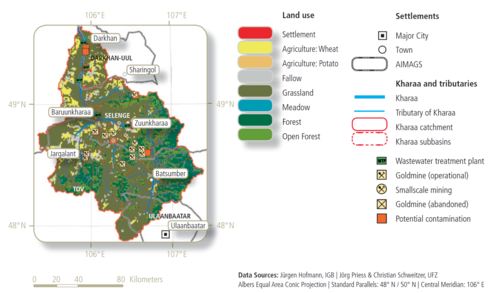Module 2: Monitoring of water quantity, quality and ecological status
Environmental monitoring seems to be one of the keys to inform decisions of local and national authorities. The components to be monitored include surface- and groundwater quantity, -quality and -use in major sectors (agriculture, households, industry and mining) are the analysis of impacts of climate change and land use change, e.g. on grasslands, crops and forests via repeated satellite-based observations. Furthermore, the improvement of local and regional documentation (e.g. collecting statistical data of actual land use; No. of livestock, etc.) may be useful for monitoring purposes.
The data sets collected by the project team allow for a much better assessment of the region‘s water resources than before, identifying both key problems and management options. As an example, the figure beside shows a new land use classification prepared by the project as well as results of ground surveys on mining-related pollution. In the second thematic module the monitoring approaches and results of project phases I and II will be implemented at Mongolian authorities. One of the main tasks is the further development of a web-based geo-data base that allows a consistent management of environmental data. Additionally, trainings and workshops will be conducted in order to implement a comprehensive environmental monitoring on the long-run. A network of three water quality monitoring stations was set up in the upper, middle and lower reaches of Kharaa River. Data are automatically transferred to an online database.
Simultaneously, already ongoing efforts to establish catchment based authorities and regulations for water resources management need to be pushed forward with high priority.
